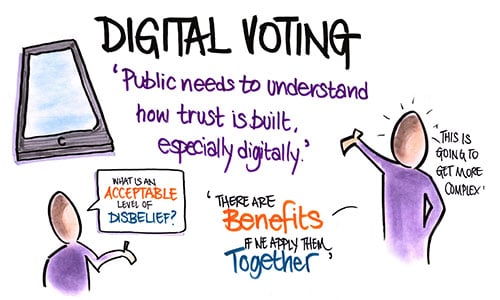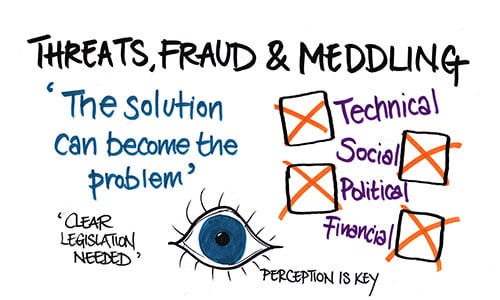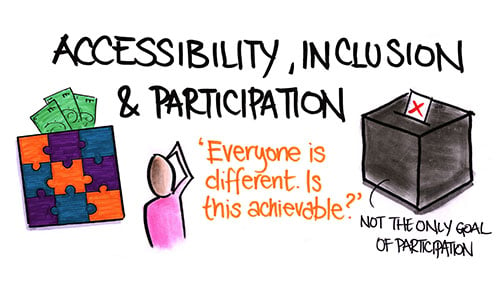25th January 2022
From digital ballot boxes to driving up turnout, the ever-quickening pace of digitalisation could change the face of democracy in the years ahead. While this offers unique opportunities to reinvigorate and strengthen democratic institutions in a digital age, digitalisation also brings with it challenges which need to be carefully addressed.
Civica’s Future Thinking programme, run through our NorthStar lab, brought together leading experts involved in delivering elections to discuss a very big topic: what democracy will look like in 2040? This timely discussion included representatives from across the public elections sphere, as well as those involved in democratic processes for trade unions, co-operatives, membership organisations, charities and companies. As well as sharing our different visions for democracy in 2040, we looked at whether systems and processes for democracy and engagement need to adapt to ensure a secure future, and the barriers that need to be addressed in order to deliver trusted, transparent and accessible democracy in future.
Our group of experts identified a wide range of trends likely to feature in the next twenty years. From those, three key ‘super-trends’ emerged that we expect to dominate the discussion and development of democratic processes in the coming decades.
Super-trend 1: Digital voting

The super-trend that every one of our experts agreed upon was digital voting. Whatever else might happen, there was a shared assumption that democracy in 2040 would include some form of digital (often called electronic) voting. Given that it has been around for over 20 years, it’s not much of a stretch.
Considering how much we now use digital channels to access services, including those provided by local authorities, the strictly analogue nature of our voting methods already seems anachronistic. From online banking and shopping to accessing medical services or paying your council tax, digital has become part of daily life for a large proportion of the UK population. So why isn’t it already available as a voting method in public elections?
The technology exists, has been used for non-public elections for decades, and continues to develop and improve. As the leading provider of election services across the UK, Civica administered the first online voting project in the UK back in 2000, and currently delivers hundreds of online voting projects every year. In fact, amongst organisations holding elections, digital has been almost exclusively the default option for more than a decade (trade unions are a notable exception as current regulations prohibit the use of digital voting for their statutory ballots).
The Electoral Commission’s report on public attitudes to modernising elections stated:
“Overall people liked the idea of online voting and saw it as being flexible, familiar to other online activities such as banking and shopping, and potentially could encourage more people to vote. However, there were some concerns about the security of online voting; the risk of not maintaining voters’ anonymity; digital literacy; and the possibility that some people could be coerced to vote in a certain way.”
A crucial factor in the move towards digital literacy has been access to and comfort with using digital devices, which has increased as device ownership and regular usage have accelerated. Our own 2021 report, A Word From The Wise, offered some important insights. Overall, 79% of over 70s feel technology is helping public service organisations provide them and the wider community with better services. 74% now own a smartphone, 69% own a laptop (higher than those aged between 18-34) and 66% use smartphones daily (up 1% from 2020). Significantly, 59% see the benefit of voting online and the same percentage have registered to vote online. As digital literacy reaches an all-time high across all age groups, the appetite for digital services is growing and elections are no exception. Offering digital voting as one of a range of methods available for voting in public elections need not exclude anyone, and may well increase accessibility for some.
Changes to overseas voting proposed in the Elections Bill, currently going through parliament, would see a large number of new overseas voters added to the electoral register. This will mean more people likely to be affected by the issues seen in 2019, when many overseas voters did not have enough time to receive and return their postal vote before the close of the poll, meaning their votes could not be counted.
Ensuring public confidence in both the process and outcome will be vital to introducing any new method of voting in public elections. Voters are used to the existing method of marking their preferred option on a ballot paper which is then counted manually, so the process for the logging and verification of votes cast digitally will need to be clearly explained through a comprehensive public information programme across multiple channels. The same would be the case with any other change to our voting system, and the Electoral Commission is already well-versed in running awareness campaigns.
Of course, fundamental to ensuring public confidence is security, and addressing that will be critical if digital voting is going to be a feature of democracy in 2040, which brings us to the second super-trend.
Super-trend 2: Threats, fraud and meddling
The second super-trend to emerge from our discussion can be broken down into two broad areas – actual or potential vulnerabilities in our democratic system which could be exploited by bad actors; and negative public perception which could undermine trust in both the process and results.

Whether or not digital voting is introduced for public elections, our democracy will still have to contend with the influences and potential threats posed by the increasing presence of digital technology in our daily lives. From disinformation and deep fakes to hacking and identity theft, we are already seeing how this trend can impact public confidence. Where election campaigns of old depended upon soapboxes, posters and lots of knocking on doors, an ever-growing array of online media platforms means it is now far easier to micro-target specific audiences and influence how they vote. This of course presents opportunities for those people or organisations who seek to unduly influence elections for malicious purposes. High-profile examples of this kind of meddling has made the headlines around the world in recent years, but legislators have so far struggled to keep pace. The Elections Bill, includes provisions requiring online campaign material to clearly identify who is behind the campaign and who created it. This will go some way to regulating this area, but how do we deal with the unregulatable? That will have to involve the networks if serious efforts are to be made to address these challenges.
Increasing digitisation of systems for administering elections, even without changes to voting methods, also presents potential threats and security will continue to be a critical area of focus. While levels of voter fraud and ballot tampering in UK elections have been consistently low, addressing public concerns will be vital to maintaining trust and transparency. If digital voting is introduced, it will not be enough simply to have a secure platform; we will also need to ensure that the electorate believes it is secure. Education will play a significant part in providing that assurance, but countering misinformation may also need to be a feature of public information programmes.
As we seek to tackle these challenges, which are likely to become more complex and multi-faceted as we get closer to 2040, we will need to strike a balance. When it comes to elections, we must take care that every security measure do not end up impeding legitimate access. Counter-disinformation initiatives can also carry risks for human rights and democracy. Measures to prevent meddling must still protect the integrity of secret ballots, while efforts to avert fraud must avoid disenfranchising eligible voters. The challenge of maintaining this isn’t new and is likely to continue. We accept a certain level of risk to avoid imposing unreasonably onerous security measures which could deter or even exclude legitimate voters. If we are to move forward in a digital space we will have to accept some risk. Do we need to have a wider public discussion about how to achieve that balance in the face of new threats?
Combined with the unknown unknowns, new developments we haven’t even imagined which may become factors by 2040, it’s clear that the industry will have to prioritise anticipating, monitoring and countering security threats. However, there may be a bigger threat we need to address. If we want a 2040 in which democracy and citizen engagement thrives, we will need to confront a significant challenge – apathy – and find ways to increase participation and tackle the steady decline in voter turnout.
Super-trend 3: Accessibility, inclusion and participation

This last super-trend concerns both improving accessibility and inclusion for certain demographic groups and increasing participation more generally to arrest falling turnout. For us to have a thriving democracy in 2040, we will need to resolve the barriers to democratic participation that currently exist for a significant proportion of the electorate.
We know that certain groups may disproportionately experience barriers that prevent them from voting, from standing for election, and from wider democratic participation. Venue accessibility, lack of interpretation, inaccessible formatting of materials, lack of facilities, and cultural barriers can all make it difficult for disabled people to participate fully. The RNIB found that less than a third (30%) of blind voters were satisfied with their experience of voting in the May 2021 elections. Some groups face barriers because they are more likely to be absent from the electoral register or not registered at their current address. Electoral administrators do already include specific efforts to target these ‘hard to reach’ groups as part of planning for elections and canvassing – including young people, over 80s, black and minority ethnic communities, homeless people and travellers – but it remains a challenge.
There have been significant improvements over the years, and the Elections Bill includes a number of proposals intended to make it easier for people with disabilities to vote, but there is still more to be done to improve accessibility and inclusion. We will also have to take account of the likely impact on these groups of any changes or new developments in how we administer elections. As AI has been applied to more and more aspects of normal life, there has been an increasing awareness of the potential for baked in bias and the need for ethical AI by design. We should learn that lesson and apply it more broadly. To achieve the democracy we want to see in 2040, we need to adopt an approach of accessibility and inclusivity by design and by default.
Improving accessibility needs to go hand in hand with improving inclusion. Enabling full democratic participation will also mean improving representation for under-represented groups. In terms of gender, ethnic background and sexuality, the 2019 General Election delivered the most diverse House of Commons so far. Of the 650 MPs elected, 10% were from ethnic minority backgrounds (versus 14% of the UK population) and at least 45 who are openly gay, lesbian or bisexual. Women make up 34% of MPs, the highest proportion ever but still far from representative of the population as a whole and way behind men in terms of equal representation. For a thriving democracy in 2040, we will have to improve inclusivity and diversity.
However, if we are going to arrest declining turnout, we will also need to find ways to increase and improve democratic engagement in general. We need to recognise that different groups engage with different tactics, messaging and channels. We need to use imagination and ingenuity to find new and better ways to engage different audiences more effectively. Digital technologies could enable the voter of 2040 to meet and interact with candidates and cast their ballot with just their smartphone. Digital technologies could, in other words, completely transform the democratic experience as well as the process. Digital voting, thanks to the ease and accessibility it offers, is likely to encourage participation, but need not prevent voters from using more traditional methods if they prefer. As the Electoral Commission’s Future of Voting report noted, ‘There are opportunities for both ease and engagement to be supported through innovations around information and the way the voting experience is designed.’
Ensuring a thriving democracy in 2040 starts now
In 1966 a TIME essay called "The Futurists" imagined the world of 2000: “remote shopping, while entirely feasible, will flop—because women like to get out of the house, like to handle the merchandise, like to be able to change their minds. Not everything that is possible will happen—unless people want it.”
While predicting the future is notoriously tricky, one thing we can be reasonably certain about is that the march of digitalisation will continue apace. This will be true for virtually every aspect of our lives and democracy is no exception. Digitalisation offers exciting opportunities to reinvigorate and sustain the democratic institutions upon which our free society is built, but of course it also has risks. We need to be preparing for both and shaping developments now. Our experts were unanimous that digital voting will feature, but it cannot become a part of our democracy in 2040 without changes to electoral legislation. The technology for secure digital voting already exists. Digital literacy has increased dramatically and is accelerating. Public confidence can be ensured through information campaigns and a wider discourse to explain processes and address concerns. Now we need to see the political commitment and legislation to make it available. Trials through the armed forces or overseas voters could test functionality and controls, as well as addressing the issues that arose for them in 2019 with postal voting. Removing the prohibition on trade unions using digital voting would be a further positive step, allowing unions and their members to benefit from the opportunities that digital voting brings.
We need to proactively anticipate and counter threats to the security and integrity of our democracy, and to safeguard public trust. We need to find ways of addressing the problem of disinformation on platforms that fall outside of the UK’s regulatory jurisdiction. We need, perhaps even more urgently, to make our democracy more inclusive and accessible for all. This cannot wait until 2040 – we need a real commitment and focus on removing barriers to participation and to building a truly inclusive and representative democracy now. We need to leverage the opportunities offered by technology and our multi-channel, multi-device modern life, applying ingenuity and determination to engage with all citizens. Then we can look forward to a thriving democracy in 2040.
Sian Roberts is Executive Director, Democracy & Governance
Illustrations by Tom Russell at Inky Thinking